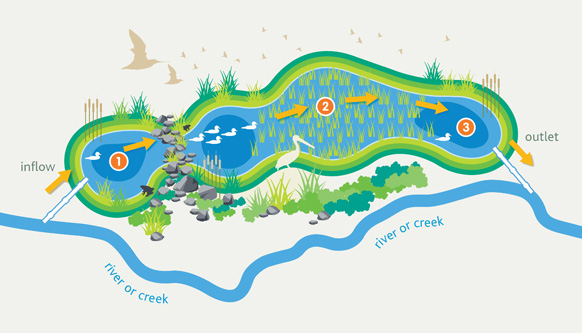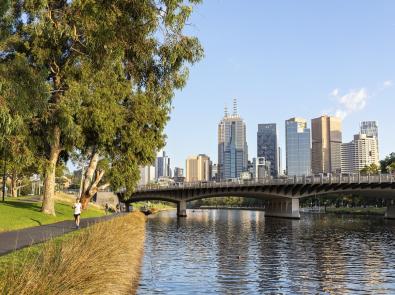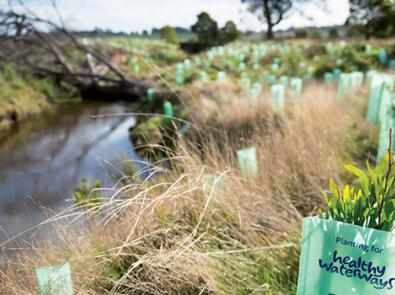Rivers, creeks and wetlands are central to everyday life, sustaining a complex ecosystem of plants and animals – and providing natural spaces for people to enjoy. Get to know some of Melbourne’s major waterways and the vital role they play.
At Melbourne Water, we manage 25,000 kilometres of waterways across Greater Melbourne. We also work with our partners to manage 33,000 hectares of surrounding open space: equal to around 13,000 MCG ovals! The work we do today ensures our rivers, creeks and open spaces remain healthy and clean into the future.
Get to know your rivers
Discover the history, geography and wildlife of Melbourne’s key rivers and wetlands with our online guides:
Bass River
Dandenong Creek
Edithvale-Seaford Wetland
Maribyrnong River
Yarra River
Werribee River
Why waterways matter
Our rivers and creeks provide habitat for more than 1,800 species of native plants and 600 species of native animals. They also supply water to homes and businesses, including the farms that grow our food, and are enjoyable places to visit.
The plants and animals that rely on rivers live together in a delicate balance. However, this can be upset by human activities that change a river’s natural state, sometimes with widespread and destructive results.
Key threats to our rivers include:
- drought and climate change
- taking water for agriculture, businesses and homes
- using more land for farming or building on — this increases the amount of surfaces like roofs and roads that cannot absorb water, which then washes litter and pollutants into our drains and creeks (stormwater pollution)
These threats make life hard for plants and animals, due to:
- habitat loss
- poor water quality
- erosion
- unnatural water temperature or flows
- barriers to migration
- flooding — which impacts people as well.
What we’re doing
We can’t restore every river and creek to its natural state, but we can help protect and improve them. Each year we undertake a significant program of works to achieve this, while balancing the needs of the community, costs and safety.
Our work includes:
- cutting grass
- controlling weeds
- planting native vegetation
- removing litter and debris
- assessing waterway condition (including safety and all abilities access)
- releasing water into rivers to mimic natural river flows (environmental flows)
- making sure councils and land developers include techniques in new houses that capture and clean stormwater (water sensitive urban design)
We also monitor and research waterways to get accurate information that guides our activities, and shows how well these are working. It can take a long time for the positive effects to show — up to 50 years for riverbank revegetation — but we know our works make an impact.
Wetlands
Natural and man-made wetlands play a number of important roles — from providing wildlife habitat and community spaces, to filtering stormwater that enters rivers and creeks.
Wetlands are areas of land temporarily or permanently covered by pools of shallow water. This ranges from fresh to salty, and may be flowing or still.
Some examples of wetlands are:
- lakes
- swamps
- floodplains
- mudflats
- estuaries
Natural wetlands
Wetland water is rich in nutrients, attracting and sustaining many different types of plants and animals. Each wetland has a unique ecosystem that provides:
- food and water
- habitat and breeding grounds
- places to shelter during drought
Several wetlands across Melbourne are home to endangered species. Two wetlands we manage are considered by the Ramsar Convention to have international importance:
Man-made wetlands
Some wetlands are built to remove harmful pollutants in stormwater before they reach our rivers, creeks and bays. They can also:
- reduce riverbank erosion by slowing the flow of water entering rivers or creeks
- lessen the impact of floods by storing excess water
- provide space for recreational activities like bushwalking and birdwatching
How wetlands work

- Water from rivers or creeks is directed into the wetland, and slowly travels through several small ponds. This lets litter, sediment and other large pollutants sink to the bottom.
- Water is filtered by micro-organisms and algae that grow on wetland plants. They remove nutrients, especially nitrogen, to help reduce algal blooms in Port Phillip Bay.
- After one to three days in the wetland, cleaner water is released back into the river or creek and water levels return to normal.
Looking after wetlands
We manage wetlands differently depending on their main purpose — animal habitat or stormwater treatment.
To protect rare and threatened species that live in our wetlands, we:
- plant native plants
- remove weeds
- control pest animals
- manage threats from stormwater pollution, salty groundwater and changes to the natural water cycle
We also need to maintain man-made wetlands so they continue working well. This involves removing rubbish and sediment that builds up over time, and replanting vegetation.
Many constructed wetlands also attract birds, frogs and mammals, and are valued by their local community for their amenity. Where possible, we try to balance these needs — for example, delaying maintenance activities to accommodate frog breeding cycles.
How you can help
There are many ways you can care for your local waterway, such as:
- counting frogs
- building a raingarden
- applying for funding to help with a river health project.

